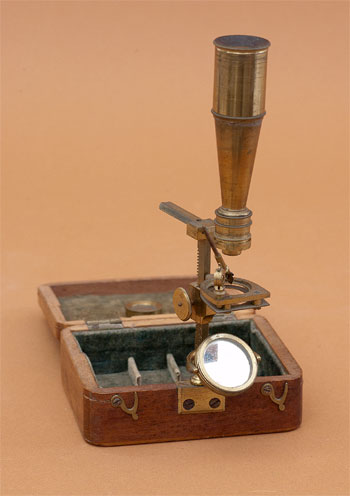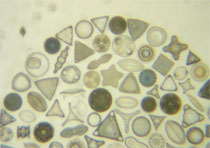 |
|||||
 |
 |
||||
 |
|||||
 |
 |
||||
Gould-Type Pocket Microscope (No. 47) |
||||||||
 |
Age: 1820–1880 Made by: Charles Gould at the Firm of William Cary Made in:England |
|||||||
 |
||||||||
|
Cary, London
|
||||||||
 |
||||||||
|
Imaging
|
||||||||
|
William Cary (1759-1825) was a prominent maker of "Mathematical Instruments" (including microscopes) located on the Strand, London. This small microscope in the Golub Collection was designed by one of his apprentices, Charles Gould, while he was working in the Cary firm, possibly after Cary's death. In 1827 Gould published a booklet entitled The Companion to the Microscope and a Description of C. Gould's Improved Pocket Compound Microscope... An engraving of a microscope similar to this one in the Golub collection is included in the frontispiece. The firm continued using Cary's name, where it was managed by Cary's nephews, and it continued to make microscopes of this style for a quite a number of years after Cary's death. Eventually Gould left the company to establish another firm as "Gould and Porter". An instrument of this type was called a "pocket microscope" because of its size and portability. Microscopes of this general design continued to be made well into the 19th Century due to their popularity among the many people with interests in natural history. This type of instrument often varied in design, some larger, some with the pillar mounted on the front edge of the box, some mounted on the top of the box, some signed, and some unsigned. These microscopes have often been called "Cary-style microscopes," while Charles Gould has become more of a footnote in spite of his creativity. To give credit to the actual designer of the microscope, the Pocket Microscope design should be called "Gould-style." It is designated this way in The Great Age of the Microscope (1989, Turner), the Molecular Expressions site, and in this Golub Collection site. This particular microscope is a small (only 17cm tall), brass compound microscope that mounts on a wood (probably mahogany) case. The microscope support shaft screws into case. The focusing mechanism is rack-and-pinion, with the rack gears machined directly into the support shaft. There are two objective lenses associated with this microscope. The specimen holder can accommodate a standard specimen holder, as well as a live box. The illuminating mirror has only one reflective side. Accessories consist of a stage forceps and a live box for water mounted specimens. Optically, this microscope exhibits chromatic and spherical aberration, however images are adequate, with lower magnification objective yielding the best image. This microscope is signed on the support pillar, "Cary, London." |
||||||||
| Featured 3/05, 4/18 | ||||||||